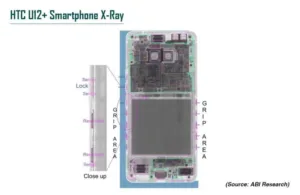The recently released HTC U12+ features the company’s proprietary Edge Sense 2 technology, which the manufacturer says brings even more ways to interact with the phone by squeezing its lower sides or edges. According to ABI Research, while the technology behind the squeeze is impressive from a technical point of view, Edge Sense 2 does not deliver a positive user experience.
However, it is how HTC embedded the Edge Sense 2 technology that impressed ABI’s Teardowns team, with ten ultrasonic sensors and nine ceramic resonators in the sides of the smartphone. The ceramic resonators create the ultrasonic wave throughout the smartphone, which is then received by one of Sentons’ ultrasonic sensors under the buttons or grip area. ABI’s James Mielke commented:
“Although we have seen a few
attempts of bringing vibration technology into smartphones, we have not seen a compelling experience to make the technology a mainstay”.
Acoustical ceramic resonator vibration is intended to replace the smartphone’s speakers but exhibits poor audio performance, analysts said. Ultrasonic ceramic vibration is used for fingerprint identification but it is a minor player compared to capacitive sensing techniques. HTC is now on the forefront of ultrasonic ceramic vibration for grip sensing.
While the ultrasonic ceramic vibration technology may be impressive, the user experience needs improvement, ABI said. Whether used to take photographs or open an application, there is a learning curve to using the squeeze function to achieve the desired result. Mielke concluded:
“The user receives no feedback as to how soft or hard to squeeze for the intended response. The Edge Sense 2 activation indicators will cause frustration. These issues could be overcome with software updates, and as the technology evolves, it could find some very interesting applications”.

